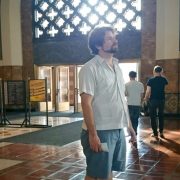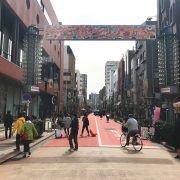From Los Angeles to Athens: Exploring Climate Change in Mediterranean Cities
By Laurel Hunt, MURP ’14, who is Programs Manager at the Loyola Marymount University Center for Urban Resilience and Secretary of the Mediterranean City Climate Change Consortium Secretariat.
Earlier this summer, with the generous support of the UCLA Luskin School of Public Affairs, the Luskin Center for Innovation, the UCLA Department of Urban and Regional Planning and the Council for Watershed Health, I had the fortunate opportunity to attend the 2014 Mediterranean City Conference in Athens, Greece. The Mediterranean City Conference brought together scientists, policy makers, elected officials, corporate sustainability leaders, engineers, planners and natural resource managers, among others, to discuss leading research and climate change adaptation strategies for Mediterranean-climate cities. The Greek European Union Presidency hosted the event along with other organizers including the Mediterranean City Climate Change Consortium (MC-4), which is a locally-born initiative that I worked with during my time as a UCLA graduate student (and still work with today). Because of my background in climate change planning and interest in its applications to urban areas, I was thrilled to be a part of such a high profile conference with some of the movers and shakers in the field.
The Mediterranean City Conference and MC-4
The Mediterranean City Conference is a bi-annual event that the Council for Watershed health first hosted in Los Angeles in 2012. The 2012 conference brought together over 230 stakeholders to discuss the following themes in climate change adaptation: Water, Energy, Biodiversity & Open Space, The Built Environment and Public Health. The conference also produced broad support for MC-4’s “Commitment to Action”, elevating its role as the leading network of academics and practitioners building resilience to climate change in Mediterranean-climate regions. As a graduate student who wanted to gain experience with climate change planning, I became involved in the MC-4 initiative through one of the Luskin School’s many fellowship opportunities. The Council for Watershed Health subsequently hired me to help manage the initiative and support the Mediterranean City Conference. Now that I have graduated from UCLA, I am the Secretary of the MC-4 Secretariat and the Programs Manager at Loyola Marymount University’s Center for Urban Resilience, which currently houses MC-4. This is a true Luskin School job success story!
Adaptation and the Mediterranean Climate
Climate change adaptation is the process of altering our current environment to face the predicted impacts of climate
change. This concept is often discussed in contrast to mitigation, the process of reducing greenhouse gas emissions. In an urban context, examples of climate change adaptation include expanding parks and open space to temper heat increases and improving evacuation plans for low-lying areas in preparation for increased flooding.
There are five Mediterranean climate zones throughout the world: California, central Chile, the Western Cape of South Africa, the Mediterranean Basin, and South and Southwestern Australia. These areas are generally characterized by hot, dry summers and cool, wet winters. Due to their similar climates, they also share many other characteristics. For example, although the Mediterranean climate covers less than 3% percent of land on earth, it is home to about 20% of plant biodiversity and over 26,000 endemic species. As a native Californian, I can also tell you that Mediterranean-climate cities are very desirable areas to live in and visit. Due to the climate-related similarities, it is critical to foster regional collaboration and knowledge sharing on climate change issues across borders.
Arrival in Athens
After travelling for a full 24 hours, I landed at Eleftherios Venizelos (Athens International Airport) at 9am. The morning light was strong for my eyes considering that I had just spent about a day on an airplane and in airports. As I peeked out the window of my taxi, I was expecting to see a foreign landscape around me. The taxi driver sped past all of the other vehicles on the road at an alarming rate as I took in the vast, dry landscape marked by shrubs and surrounded by mountains – it looked just like Los Angeles. Dr. Bowman Cutter of Pomona College, a professor also attending the 2014 The Mediterranean City Conference agreed – in terms of landscape, it was almost as if we hadn’t left the Los Angeles Basin and were gazing out at the San Gabriel mountain range.
Though we were sleep-deprived and felt hazy in the morning light, Professor Cutter and I decided to take advantage of the four days that we had in Athens and headed directly for the city’s port, Piraeus. We hopped on the first ferry out of town to the island of Aegina. After a long day of exploring the narrow cobblestone roads, brightly painted homes and pistachio orchards, we headed back to the dock where I dipped my feet in the Mediterranean Sea. That evening, we went out to dinner with a cohort of MC-4 members from California attending the conference and had a delicious Greek meal.
2014 The Mediterranean City Conference
The conference consisted of two tightly packed days of speakers, breakout discussion groups and poster sessions at the Divani Caravel Hotel in the Kesariani neighborhood of Athens, located only two miles from the famed Acropolis. At the poster sessions, I presented research led by Dr. Cutter. Specifically, he conducted a survey of 28 Mediterranean-climate cities and regions in 18 countries across the world with the goal of developing ways to examine the implementation of climate adaptation plans. I analyzed his findings and used them to make a case for regional collaboration through networks like MC-4. In the future, Dr. Cutter will identify planning gaps and recommend where additional planning efforts can be most effective. The MC-4 network also hopes to be able to suggest specific city-to-city partnerships that leverage existing programs and policies. Overall, it was fascinating to attend a conference based on future outcomes in a city steeped in ancient human history.
The speakers at the conference addressed the state of climate change adaptation in Mediterranean climate zones with a particular focus on the Mediterranean Basin. They were a diverse group of researchers, urban planners, scientists, policymakers and regulators.
One speaker, Kurt Vandenberghe, the Director for Climate Action and Resource Efficiency for the European Commission, reported on the importance of targeting cities for action on climate change. He explained that cities have the important combination of large economies and creative energy that can produce widespread grassroots mobilization. He also shared his thoughts on the importance of information sharing and bolstering a strong information market.
Another speaker, Dr. Thomas Stocker, a climate change scientist and contributor to the fifth Intergovernmental Panel on Climate Change report, described how humans impact changes in the atmosphere and the importance of making predictions about possible futures. I thought it was particularly important that Dr. Stocker emphasized the idea of multiple futures and the general open-endedness of climate change mitigation and adaptation. He made it clear that reduction of greenhouse gas emissions will have to be sustained and substantial stating, “When we finish with adaptation in the 21st century, we are not finished. We will have to move on to adaptation in the 22nd century.”
Barbara Norman of the University of Canberra led a dynamic Urban and Regional Planning breakout group discussion on “Adaptation Challenges, Adaptation Strategies in the Mediterranean City”. Norman discussed planning for climate change while taking into account considerations of the built environment, biodiversity, water and coastal urbanization. She also emphasized the importance of integrated solutions to implementing plans.
At one point during the breakout session, a group of urban planners from Italy expressed their frustration about the lack of products and services available for them to utilize on a local level. As an urban planner, I also thought about how the cutting-edge research being conducted by many of the academics at the conference could be applied to regional and local climate change adaptation efforts. In other words, how can we link the people who are working on creating climate change adaptation plans to appropriate data and technical tools? In the process of coordinating these efforts, I also wondered what new types of partnerships would be forged.
Conference Reflections
Though there were several fascinating speakers and discussions that occurred during breakout sessions and panels, I realized that some of the most important grassroots work being accomplished at the conference was happening between formal events in conversations and meetings. For example, during the lunch break on the second day of the conference, I helped to organize a lunch meeting between current MC-4 members and other interested conference attendees. While the knowledge of climate change adaptation research and applications that I gained at the conference was certainly valuable, networking and bonding with colleagues was one of the most important aspects of this event. I hope to carry these connections forward as I work with other network members to design a research strategy for MC-4.
Exploring Athens
In addition to attending the conference, I got out of the hotel and went on some whirlwind tours of the Mediterranean City around me. One night, I went out to dinner with the other event attendees at a restaurant across from the Acropolis with a view of the Parthenon and the Temple of Athena Nike. As the sun set, I felt privileged to be sitting across from the historic structures towering above the city on a hill. The light soon faded in the sky and the Acropolis became brightly illuminated by spotlights creating quite a spectacle. That evening, I strolled for a few miles through the city. Many people were out enjoying the night and I even walked by musicians playing traditional Greek music as well as an extensive group of bicycle riders.
The next two evenings were similarly fantastic: I attended an outdoor reception for the MC-4 network that I helped to organize at the National Observatory of Athens with a view of the old city, the “Plaka”. At this event, I connected with current and prospective MC-4 members over hor d’oeuvres. On the final night that I was in Greece, I made my way through the Plaka, chatted with shop owners and made sure to try as much Greek food as I could. (The food, everything from goat cheese with Greek honey to olives and freshly baked breads, was certainly a highlight of the trip!)
I know that there is a lot more to do and see in Athens and I won’t complain if I ever have an excuse to go back…
Final Thoughts
Traveling to Athens for the 2014 The Mediterranean City Conference was one of the most exciting opportunities I have ever had and I look forward to continuing my work to strengthen MC-4 and advance climate change adaptation planning across sectors and political boundaries. Keep your eyes and ears open for more from me about climate change adaptation in Los Angeles and beyond!
Thank You


















Leave a Reply
Want to join the discussion?Feel free to contribute!